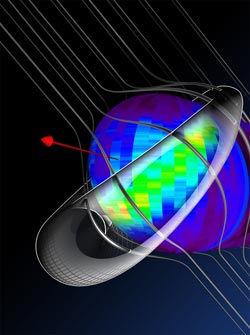Enigmatic "Ribbon" Of Energy Discovered by NASA Satellite Explained

A three-dimensional diagram of the retention region shown as a "life preserver" around our heliosphere bubble along with the original IBEX ribbon image. The interstellar magnetic field lines are shown running from upper left to lower right around the heliosphere, and the area where the field lines "squeeze" the heliosphere corresponds to the ribbon location. The red arrow at the front shows the direction of travel of our solar system. Image credit: Adler Planetarium/IBEX Team. <br>
In a paper published Feb. 4, 2013, in the Astrophysical Journal, researchers, including lead author Nathan Schwadron of the University of New Hampshire, propose a “retention theory” that for the first time explains all the key observations of this astrophysical enigma.
“If the theory is correct,” Schwadron notes, “the ribbon can be used to tell us how we're moving through the magnetic fields of the interstellar medium and how those magnetic fields then influence our space environment.”
In particular, these strong magnetic fields appear to play a critical role in shaping our heliosphere – the huge bubble that surrounds our solar system and shields us from much of harmful galactic cosmic radiation that fills the galaxy. This may have important ramifications for the history and future of radiation in space, and its impact here on Earth, as the heliosphere changes in response to changing conditions in the interstellar medium or the “space between the stars.”
According to the retention theory, the ribbon exists in a special location where neutral hydrogen atoms from the solar wind move across the local galactic magnetic field. Neutral atoms are not affected by magnetic fields, but when their electrons get stripped away they become charged ions and begin to gyrate rapidly around magnetic field lines. That rapid rotation creates waves or vibrations in the magnetic field, and the charged ions then become trapped by the waves. This is the process that creates the ribbon.
Says Schwadron, an associate professor at UNH's Institute for the Study of Earth, Oceans, and Space and department of physics, “Think of the ribbon as a harbor and the solar wind particles it contains as boats. The boats can be trapped in the harbor if the ocean waves outside it are powerful enough. This is the nature of the new ribbon model. The ribbon is a region where particles, originally from the solar wind, become trapped or 'retained' due to intense waves and vibrations in the magnetic field.”
The Astrophysical Journal paper is titled “Spatial Retention of Ions Producing the IBEX Ribbon” and is coauthored by Dave McComas of the Southwest Research Institute and principal investigator for the IBEX mission.
Says McComas, “This is a perfect example of the scientific process: we observe something completely new and unexpected with IBEX, develop various hypotheses to explain the observations, and then develop mathematical models to try to validate the hypotheses.”
Indeed, since the discovery of the ribbon, more than a dozen competing theories seeking to explain the phenomenon have been put forth. The retention theory “checks all the boxes, agrees with all the available observations, and the mathematical modeling results look remarkably like what the ribbon actually looks like,” notes Schwadron. “This substantially raises the bar for models that attempt to explain the ribbon.”
IBEX was launched in October 2008 and has provided images of the invisible interactions between the solar wind and the local galactic medium. The ribbon was captured using ultra-high sensitive cameras – one of which has components designed and built at the UNH Space Science Center – that image energetic neutral atoms (instead of photons of light) to create maps of the boundary region between our solar system and the rest of our galaxy.
Although the retention theory may check all the boxes, the IBEX team is still far from claiming that the ribbon is fully explained. A major test for the retention theory will be watching how the ribbon changes in step with observed changes in the solar wind. Notes Schwadron, “If what we observe matches what the model predicts should happen to the ribbon as the solar wind changes, that will go a long way toward validating the model.”
IBEX is the latest in NASA's series of low-cost, rapidly developed Small Explorer space missions. Southwest Research Institute in San Antonio, Texas, leads the IBEX mission with teams of national and international partners. NASA's Goddard Space Flight Center in Greenbelt, Md., manages the Explorers Program for NASA's Science Mission Directorate in Washington, D.C.
Media Contact
All latest news from the category: Physics and Astronomy
This area deals with the fundamental laws and building blocks of nature and how they interact, the properties and the behavior of matter, and research into space and time and their structures.
innovations-report provides in-depth reports and articles on subjects such as astrophysics, laser technologies, nuclear, quantum, particle and solid-state physics, nanotechnologies, planetary research and findings (Mars, Venus) and developments related to the Hubble Telescope.
Newest articles

Silicon Carbide Innovation Alliance to drive industrial-scale semiconductor work
Known for its ability to withstand extreme environments and high voltages, silicon carbide (SiC) is a semiconducting material made up of silicon and carbon atoms arranged into crystals that is…

New SPECT/CT technique shows impressive biomarker identification
…offers increased access for prostate cancer patients. A novel SPECT/CT acquisition method can accurately detect radiopharmaceutical biodistribution in a convenient manner for prostate cancer patients, opening the door for more…

How 3D printers can give robots a soft touch
Soft skin coverings and touch sensors have emerged as a promising feature for robots that are both safer and more intuitive for human interaction, but they are expensive and difficult…





















